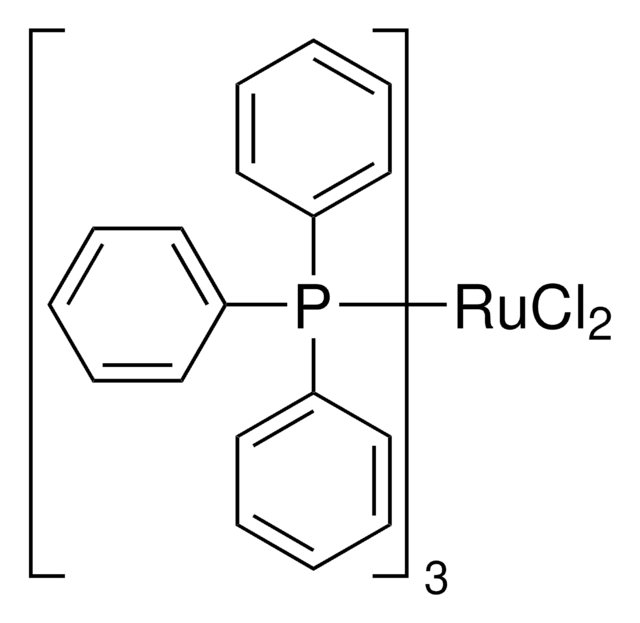739103
Ru-MACHO®
Synonym(s):
Carbonylchlorohydrido{bis[2-(diphenylphosphinomethyl)ethyl]amino}ethyl]amino}ruthenium(II), {Bis[2-(diphenylphosphino)ethyl]amine}carboynlchlorohydridoruthenium(II)
About This Item
Recommended Products
form
solid
Quality Level
reaction suitability
core: ruthenium
reagent type: catalyst
mp
260-290 °C
SMILES string
Cl[Ru].[C-]#[O+].C(CP(c1ccccc1)c2ccccc2)NCCP(c3ccccc3)c4ccccc4
InChI
1S/C28H29NP2.CO.ClH.Ru/c1-5-13-25(14-6-1)30(26-15-7-2-8-16-26)23-21-29-22-24-31(27-17-9-3-10-18-27)28-19-11-4-12-20-28;1-2;;/h1-20,29H,21-24H2;;1H;/q;;;+1/p-1
InChI key
GQFWSAKCCNATEV-UHFFFAOYSA-M
Application
<li><strong>Dehydrogenative Intramolecular Macrolactonization:</strong> Ru-MACHO catalyst is applied in dehydrogenative intramolecular macrolactonization of dihydroxy compounds, demonstrating its efficiency in organic synthesis with potential implications for pharmaceutical synthesis (Jamdade et al., 2022).</li>
<li><strong>Acceptorless Dehydrogenation of Methanol:</strong> Employing Ru-MACHO catalyst in the acceptorless dehydrogenation of methanol to produce carbon monoxide and hydrogen, this process highlights Ru-MACHO′s capability in catalytic transformations and green chemistry applications (Kaithal et al., 2021).</li>
<li><strong>Precapture and Hydrogenation of CO2:</strong> A study on the heterogenized Ru-MACHO catalytic systems for pre-capture and hydrogenation of CO2 into methanol, underscoring the catalyst′s potential in sustainable chemical processes (Szego et al., 2023).</li>
<li><strong>Pressure-dependent Hydrogenative Depolymerization:</strong> The Ru-MACHO catalyst is used for highly selective pressure-dependent hydrogenative depolymerization of polybutylene succinate, demonstrating the catalyst′s versatility in polymer processing and chemical recycling (Johnson et al., 2024).</li>
</ul>
Legal Information
Signal Word
Warning
Hazard Statements
Precautionary Statements
Hazard Classifications
Eye Irrit. 2 - Skin Irrit. 2 - STOT SE 3
Target Organs
Respiratory system
Storage Class Code
11 - Combustible Solids
WGK
WGK 3
Flash Point(F)
Not applicable
Flash Point(C)
Not applicable
Choose from one of the most recent versions:
Already Own This Product?
Find documentation for the products that you have recently purchased in the Document Library.
Articles
Learn about Ester Hydrogenation from MilliporeSigma. The reduction of esters to alcohols is typically accomplished using metal hydrides. While effective, it comes at the cost of stoichiometric waste and complicated workup procedures.
Our team of scientists has experience in all areas of research including Life Science, Material Science, Chemical Synthesis, Chromatography, Analytical and many others.
Contact Technical Service



![Dichlorotriphenylphosphine[2-(diphenylphosphino)-N-(2-pyridinylmethyl)ethanamine]ruthenium(II) 97%](/deepweb/assets/sigmaaldrich/product/structures/303/584/056e7e0c-3dde-4c68-9250-78fed40d37cb/640/056e7e0c-3dde-4c68-9250-78fed40d37cb.png)
![Dichlorotriphenylphosphine[bis(2-(ethylthio)ethyl)amine]ruthenium(II) 97%](/deepweb/assets/sigmaaldrich/product/structures/355/871/c9ac8b63-9a77-4c66-b545-cb7c41673aa4/640/c9ac8b63-9a77-4c66-b545-cb7c41673aa4.png)




